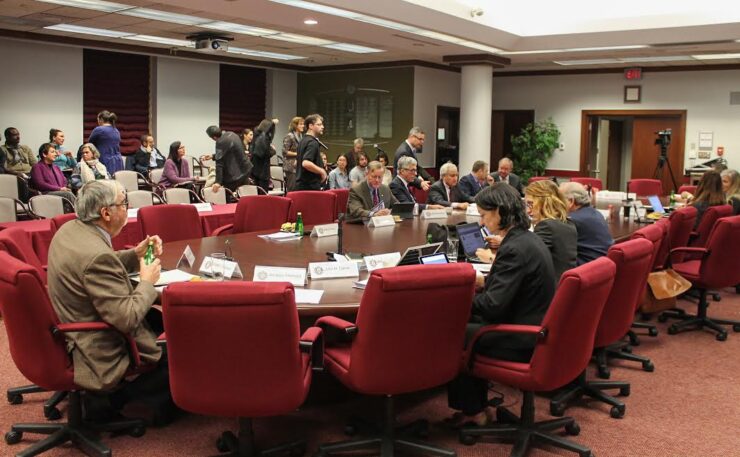Student experiences show marketing and public relation campaigns aren’t enough
Content Warning: The following discusses struggles with mental health and suicide.
I have worked at the Fulcrum for three years now, and in this time I’ve witnessed and written about countless issues on our University of Ottawa campus. I observed a student union crumble under the weight of fraud allegations against its executive, wrote about racially motivated carding incidents, covered anti-racism protests and reported on a global pandemic shutting down campus.
However, I seem to have been somehow mostly spared from writing about mental health. Of course, I have written the occasional article, but I’ve never had to directly write about the mental health ‘crisis’ and the university’s response — until this week.
On Dec. 7, one day after the Fulcrum’s Editorial Board went on break from work, the President’s Advisory Committee on Mental Health and Wellness released its final report to the University of Ottawa’s Board of Governors (BOG).
Personally, it was mentally exhausting to read through the report and fully understand how the administration perceives the mental health crisis and how different it is from the perception of students that live through it everyday.
The thing is, I may not have directly covered the mental health crisis on campus, but I’ve seen how the crisis itself and its coverage has affected present and former colleagues of mine at the Fulcrum.
I’ve witnessed colleagues breakdown.
I have observed co-workers become distraught after learning of a fellow student’s death through an email announcement.
I’ve consoled co-workers who suffered from trauma associated with the coverage of the mental health crisis.
I watched as the inevitable trauma associated with the coverage of the crisis led to burn out and forced friends to take time off from the paper.
I have encouraged fellow colleagues to share their experiences with mental health services on campus and believed their stories would help others in the same situation.
With that in mind, I pondered on how best to report on this heavily weighted topic. I decided to simply write an article sharing as objectively as possible the recommendations of the report. I did this to let our readers judge the content for themselves.
Soon after the publication of the article, I realized I needed to write a piece representing the voices of my present, and to the best of my ability, former colleagues who have dedicated much time and energy to covering the mental health crisis on campus — often at the detriment of their own mental health.
Naively enough, I thought this report would be focused on how the university should help students who are in crisis and need immediate help. Many students cannot afford private help and need more than eight visits with a counsellor, however, this was not the theme of the recommendations.
And I should have known, Kevin Kee, the head of the committee literally stated in front of the BOG, that he followed the advice of a Harvard professor who told him the key to changing students’ perception of the mental health situation is to “switch the narrative … share positive stories instead of negative ones.”
What does that look like in practice? It looks like some of the recommendations in the committee’s report.
Over half of the recommendations are suggestions on how the university’s public relations department can better sell the idea that the university cares about its student’s mental health.
One statement that seems to be repeated indirectly many times in the report, is that students don’t get help because they don’t know how to find or access the resources that are available to them (see recommendation number four).
In February, my former colleague Zoe Mason wrote about gaps in the mental health system at the university. In the feature, she revealed she attempted to book an appointment in December 2019 for a psychiatric assessment only to be told the next available date for an appointment was in July 2020 — a seven month wait.
And her story is one of many.
The recommendation to “develop a transparent communications strategy and revisit protocols” is nothing but transparent. This recommendation is the embodiment of “changing the narrative.”
“Students expressed concern about the goals, timeliness and transparency of the well-intentioned University communications about student deaths,” wrote the committee in the report.
“More targeted communications (to members of the department and/or faculty community), alongside moments for the community to gather in mourning, could address those concerns.”
Now, do not get me wrong, it can be a traumatic experience getting an email about a student dying but limiting communications is not the way to go. This, in my opinion, is a clear tactic to sweep the mental health crisis under the rug.
Without university-wide communication, it is less likely that outlets such as the Fulcrum and la Rotonde will be made aware of a student’s death — and therefore unable to challenge the execution and capabilities of the university’s mental health services.
Theoretically if there are no reports of student deaths, then in theory, the university must be doing better in terms of mental health and wellness. My suggestion for students who do not wish to receive these communications is to be given the option to opt out of receiving the mass emails.
This recommendation also suggests:
“Mental health and wellness must become a central theme in the University’s communications. We recommend the implementation of a comprehensive communications strategy that promotes a culture of wellness, prioritizes mental health understanding and resource awareness, in multiple formats, on and off campus, and that include specific strategies and approaches to target messaging to marginalized groups.”
Yes, promoting mental health and wellness is good, but actions are better.
Another recommendation that seems to be aimed at producing positive marketing material for the university is recommendation number one: “Sign the Okanagan Charter and implement the standards.”
The Okanagan Charter was designed to provide post-secondary institutions with a framework centered around principals and common language to become a “health and wellbeing promoting campus.”
Per the recommendation, post-secondary institutions who sign the Okanagan Charter pledge to work to achieve its two calls to action:
- “To embed health into all aspects of campus culture, across the administration, operations and academic mandates;
- To lead health promotion action and collaboration locally and globally.”
On Monday morning, the U of O will officially (virtually) sign the Okanagan Charter. In other words, they will commit to promoting mental health better.
The next suggestion I take issue with is found in recommendation number four: “Strengthen and increase the profile of the wellness website and implement a virtual wellness hub.”
This suggests that students, according to the report, don’t know how to find the website where they can book appointments with counsellors and psychiatrists — it appears like a seven month waitlist would indicate otherwise.
Now, this is not to say that all the recommendations the committee made are public relations related — but many are. Parts of recommendation number five should certainly be implemented by the university. Those are:
- “Implement a physical ‘One Stop Shop’ mental health and wellness centre on campus, creating a centralized hub for access to mental health and wellness services to ensure timely, accessible, coordinated and stepped care services;
- Hire additional professional counsellors as required to ensure access to supports and services with short wait times;
- Evaluate the need for specialized counsellors (who could be especially responsive to intersectional mental health factors such as racism, discrimination (including but not limited to those who identify as LGTBQ2S+, sexual violence, or disordered eating) for populations with differing needs like undergraduate and graduate, domestic and international students, in both English and French, and then take appropriate action.”
If these elements are implemented, the issue of availability of services for students would undoubtedly be improved. It is important the diversity of our student body be represented by the staff it pays for in its tuition. Especially staff working in the mental health sector.
I remember sitting at the mental health town hall in March 2020, listening to BIPOC and Francophone students explaining how they are underrepresented in the U of O’s mental health system.
“[There is] only one French counsellor who is an older white man, that doesn’t represent diversity and it’s challenging for people who are not white men,” said a first-year feminist studies student at the time.
A mental health centre would benefit students since as of right now, it seems like the only space available is on the fourth floor of the University of Ottawa’s Health Services’ Marie-Curie clinic. This may not change much in the coming months as most students are learning virtually from their hometowns, but when life comes back to ‘normal’ it would definitely be a step forward.
Of course, this may require the university to spend money either on a new building or transforming an existing area into a mental health centre — it is not a cheap solution but mental health is worth investing in.
Another interesting recommendation is recommendation number two: “Implement a coordinated approach to mental health and wellness.” The committee recommends the university empowers special advisor in mental health professor Elizabeth Kristjansson to have the abilities to:
- “Ensure alignment of our resources, initiatives and offices, especially in support of students in crisis;
- Develop and implement a long-term strategy for achieving mental health and wellness at uOttawa. Such a strategy would be similar to those implemented at the University of Toronto, the University of British Columbia, and closer to home, at Carleton University;
- Along with appropriate partners, ensure the implementation of the stepped care model university-wide so that mental health resources, information and interventions are easily accessible for students. The model was put into place in 2018 in Counselling Services but has not yet been implemented University-wide.”
If given these powers by the administration Kristjansson could implement a number of changes that would help all students and staff at the University of Ottawa.
The report also suggested expanding mental health training for professors and staff, strengthening partnerships with community-based organizations and hospitals and the creation of a research cluster into mental health — all good recommendations.
The hope is the university will be able to differentiate the recommendations that will actually bring change from the ones that will simply be applied with words such as recommendation number eleven: “Include mental health and wellness in syllabi and offer mental health curricula.”
That is if the university decides to defy the conventional and implement the recommendations at all.
A non-comprehensive list of local mental health resources appears below…
On campus…
- University of Ottawa Health Services (UOHS), 100 Marie-Curie Private
- Offers counselling, psychiatric services, individual, couple or family therapy, access to psycho-educational groups and referrals to specialists off-campus
- Student Academic Success Service (SASS), 100 Marie-Curie Private
- Offers individual counselling, peer-counselling, workshops, online therapy and group counselling using new stepped model; referrals
- Faculty mentoring centres (locations differ by faculty)
- Specialized mentoring services catered to the needs of students in each faculty
- University of Ottawa’s Health Promotion (UOHP), UCU 203
- Offers peer wellness chats and resources online in French and English
Off campus…
- Mental health hotlines…
- Drugs and Alcohol Helpline: 1-866-531-2600
- Fem’aide: 1-877-336-2433
- Good2Talk: 1-866-925-5454
- Kids Help Phone: 1-800-668-6668 or text CONNECT to 686868
- Mental Health Crisis Line: 613-722-6914
- Distress Centre of Ottawa and Region: (613) 238-3311
- Ottawa Rape Crisis Centre: 613-562-2333
- Tel-Aide Outaouais: 613-741-6433
- Trans Life Line: 1-877-330-6366
- Walk-in counselling clinics (six Ottawa locations)…
- Somerset West Community Health Centre (55 Eccles Street)
- South-East Ottawa Community Health Centre (1355 Bank Street)
- Family Services Ottawa (312 Parkdale Avenue)
- Jewish Family Services of Ottawa (300-2255 Carling Avenue)
- Ottawa Community Immigrant Services Organization(959 Wellington St. W)
- CFS/SFC Ottawa (310 Olmstead Road)
- Community health and resource centres (13 in Ottawa)
- Carlington Community Health Centre (900 Merivale Road)
- Eastern Ottawa Resource Centre (215-1980 Ogilvie Road)
- Nepean, Rideau and Osgoode Community Resource Centre (1547 Merivale Road, Unit 240)
- Rideau-Rockcliffe Community Health Centre (225 Donald Street)
- Sandy Hill Community Health Centre (221 Nelson Street)
- South East Ottawa Community Health Centre (1355 Bank Street)
- Western Ottawa Community Resource Centre (2 MacNeil Court)
- Centretown Community Health Centre (420 Cooper Street)
- Lowertown Community Resource Centre (40 Cobourg Street)
- Orleans-Cumberland Community Health Centre (240 Centrum Boulevard)
- Pinecrest-Queensway Community Health Centre(1365 Richmond Road)
- Somerset West Community Health Centre (55 Eccles Street)
- Vanier Community Service Centre (270 Marier Avenue)
This editorial was written from the perspective of the Fulcrum’s Editor-in-Chief, however, the thirteen-person editorial board of the Fulcrum supported the views expressed. To share your own views, email editor@thefulcrum.ca.





